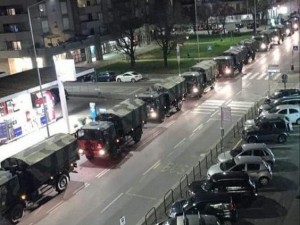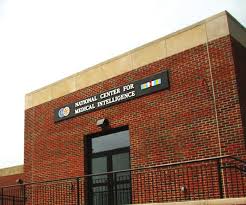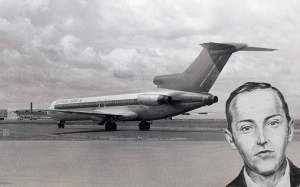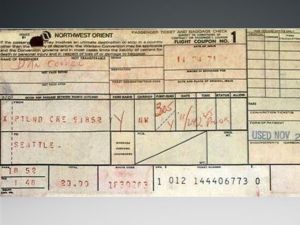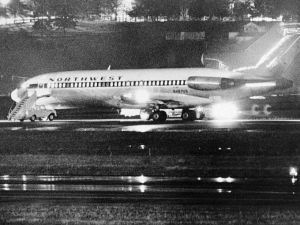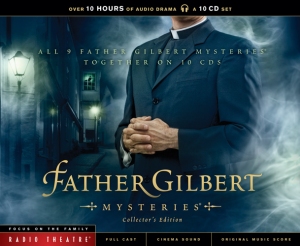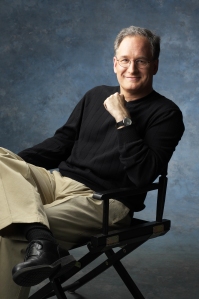

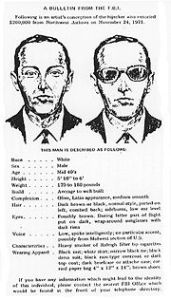


As a writer, there are sometimes a few stories at least that you just love to write about. It was fun when you started and it never seems to get old to you (other readers, who knows, but pageviews suggest the interest is more than solitary). The story of D.B. Cooper is one of those types of stories. I’m not positive, as the story has long fascinated me, but I think I may have started writing about it almost nine years ago now in a Nov. 23, 2009 column for the Thompson Citizen, simply headlined, “The mystery of D.B. Cooper.” The bonus with the D.B. Cooper story is you can be pretty much guaranteed a new angle, often in the form of a previously unnamed suspect, about this time every November. Not bad for a crime story that began on Nov. 24, 1971 – the day before American Thanksgiving that year.
Other than the most important missing basic fact – the true identity of D.B. Cooper – most of the other basics have been canvassed comprehensively in the media over the last 47 years. On Nov. 24, 1971, someone using the alias Dan Cooper, which quickly got mistakenly turned into D.B. Cooper, committed the most audacious act of air piracy in U.S. history with the mid-afternoon skyjacking of Northwest Orient Airlines Flight 305, a Boeing 727 jetliner flying over the Pacific Northwest, en route from Portland, Oregon to Seattle, Washington with 36 passengers and six crew members aboard.
“Following one of the longest and most exhaustive investigations in our history,” said Ayn Dietrich-Williams, a public affairs specialist with the FBI Seattle Field Office, “on July 8, 2016, the FBI redirected resources allocated to the D.B. Cooper case in order to focus on other investigative priorities. During the course of the 45-year NORJAK investigation, the FBI exhaustively reviewed all credible leads, co-ordinated between multiple field offices to conduct searches, collected all available evidence, and interviewed all identified witnesses. Over the years, the FBI has applied numerous new and innovative investigative techniques, as well as examined countless items at the FBI Laboratory. Evidence obtained during the course of the investigation will now be preserved for historical purposes at FBI Headquarters in Washington, D.C.”
My friend, Ian Graham, who succeeded me as editor of the Thompson Citizen and Nickel Belt News in 2014, posted on Facebook July 12, 2016 – four days after Dietrich-Williams’ announcement – that “Fox Mulder will continue to investigate regardless. And possibly John W. Barker,” Graham wrote at the time. As it turns out, closing the official FBI investigation has not proven to be a bar to journalists, still milking or mining, depending on one’s perspective, of course, the D.B. Cooper story since the FBI signed off on the file 2½ years ago.
While the FBI closed the unsolved D.B. Cooper case on July 8, 2016, various new developments continue to crop up, as they have consistently for more than four decades now. Citizen Sleuths, formed in 2007, is made up of Cooper armchair detective hobbyists, albeit ones with scientific training and with electron microscopes, who were actively encouraged over the decade before the FBI closed the case to work on the Cooper puzzle.
Six months after the FBI closed NORJACK, its D.B. Cooper investigation after 45 years, America’s most famous skyjacking was back in the news in January 2017 with the Rare Earth Elements (REE) forensic discovery by scientists and investigators from Citizen Sleuths of cerium and strontium sulfide, along with pure titanium, adding another twist to the 1971 skyjacking story, after they examined the JC Penney clip-on tie left behind by Cooper. Citizen Sleuths discovered a number of Rare Earth Elements (REE) on its surface, including cerium and strontium sulfide, along with pure titanium, which indicate that Cooper may have worked as an engineer for Boeing Company before the historic hijacking – and went out on the shop floor. Only managers and engineers wore ties in such plants at that time. Using a fully automated scanning electron microscope, they were able to pull more than 100,000 particles from the tie, which contained traces of Rare Earth Elements. Those elements were used at the time of Cooper’s hijacking by Boeing at its assembly plant in Everett, Washington, 29 miles north of Seattle, in the production of high-tech electronics such as radar screens for their Super Sonic Transport Plane.
In October 2017, the FBI released more documents pertaining to the D.B. Cooper hijacking case, including a letter that may only deepen the mystery.
“I knew from the start that I wouldn’t be caught,” says the undated, typewritten letter from a person claiming to be the man who said he had a bomb and commandeered the Northwest Airlines flight from Portland to Seattle on Nov. 24, 1971. “I didn’t rob Northwest Orient because I thought it would be romantic, heroic or any of the other euphemisms that seem to attach themselves to situations of high risk,” he said.
The carbon-copy letter was turned over to the FBI three weeks after the hijacking by The Washington Post, The New York Times, The Los Angeles Times and the Seattle Times, which were each mailed a copy and published stories about its contents. The letter was in an envelope with a greater Seattle area postmark.
The FBI released a copy of the letter that was sent to The Washington Post in response to a Freedom of Information Act lawsuit brought by D.B. Cooper sleuth Tom Colbert, a Los Angeles TV and film producer. He believes the letter is real. Colbert believes Robert W. Rackstraw Sr., a retired university instructor and arbitration expert, now living in San Diego, California, is D.B Cooper, which Rackstraw has repeatedly denied.
As for the letter, “We have no doubt it’s from Cooper and the reason is that he cites he left no fingerprints on the plane,” Colbert said. “The reason that’s critical is because it’s absolutely true.”
“There were no prints found in the back of plane,” Colbert said. “They found 11 partial prints that’s all, sides, fingers, tips and palm. But no prints of value were found.”
The letter writer says, “My life has been one of hate, turmoil, hunger and more hate; this seemed to be the fastest and most profitable way to gain a few fast grains of peace of mind,” the letter said. “I don’t blame people for hating me for what I’ve done nor do I blame anybody for wanting me to be caught and punished, though this can never happen.”
The person wrote that he wouldn’t get caught because he wasn’t a “boasting” man, left no fingerprints, wore a toupee and “wore putty make-up.”
“They could add or subtract from the composite a hundred times and not come up with an accurate description,” the letter said, adding, “and we both know it.”
The most recent development came five days ago – Tuesday, Nov. 13, 2018 – when author and true crime journalist Douglas Perry in The Oregonian in Portland, identified in a longform piece William J. Smith as the latest new suspect in the Cooper case, a suspect unearthed by an anonymous U.S Army data analyst, who says he turned over his research to the FBI last summer (https://www.oregonlive.com/expo/news/erry-2018/11/e18eba2aa14557/new-suspect-in-db-cooper-skyja.html). The Daily Mail on Thursday described D.B. Cooper as “one of the 20th century’s most compelling masterminds.” Still, you might want to take that with a grain of salt as Wikipedia editors in February 2017 voted to ban Britain’s Daily Mail as a source for the website in all but exceptional circumstances after deeming the news group “generally unreliable.”
The move was highly unusual for the online encyclopedia, which rarely puts in place a blanket ban on publications and which still allows links to sources such as Kremlin backed news organisation Russia Today, and Fox News, both of which have raised concern among editors.
The Wikipedia editors last year described the arguments for a ban as “centred on the Daily Mail’s reputation for poor fact checking, sensationalism and flat-out fabrication.”
The FBI, for its part, has not commented on the latest development in the case-that-never dies, unlike Smith, who worked for Penn Central Transportation, and died when he was 89 last January. A 1946 high school yearbook of his included a list of alumni who were killed during the Second World War. One name jumped out, according to the Oregonian: Ira Daniel Cooper. Smith, a New Jersey native, also worked at the Oak Island rail yard in Newark, and served in the U.S. Navy. The anonymous army analyst drew his conclusions in part after reading a 1985 book called D.B. Cooper: What Really Happened, written by Max Gunther, the newspaper reported. Gunther wrote in the book he was contacted in 1972 by a man who claimed to be the infamous skyjacker. However, the mysterious man who contacted Gunther eventually cut off communication with him, forcing Gunther to move on from the story. Ten years later, a woman who identified herself as Clara reached out to Gunther and claimed she was the widow of “Dan LeClair,” who had previously reached out to the author claiming he was the real D.B. Cooper.
The anonymous army analyst believes that Dan Clair, a Second World War veteran, who died in 1990, and was supposedly Gunther’s original source in 1972, with Gunther’s 1985 book detailing the story of Clara, and her husband, Dan LeClair, who were actually William J. Smith, known as Bill, and his wife, Dolores Smith, but that it was Smith, a friend of Clair’s, who was actually D.B. Copper. The data analyst theorizes that Smith probably used his friend Clair’s life story to hide his real identity when corresponding with Gunther in 1972, and that his wife, Dolores, took over communication a decade later when Smith decided once again to tell his tale. Simple enough, eh?
The man now known by the alias D.B. Cooper paid $20 cash, which included tax, for his airline ticket in Portland. Once on board, Cooper, a nondescript man possibly with a slight Midwestern accent, ordered a bourbon-and-soda, before passing a note to flight attendant Florence Schaffner demanding $200,000 ransom in unmarked $20 bills and two back parachutes and two front parachutes. ‘I HAVE A BOMB IN MY BRIEFCASE. I WILL USE IT IF NECESSARY. I WANT YOU TO SIT NEXT TO ME. YOU ARE BING (sic) HIJACKED.’ Initially, Schaffner dropped the note unopened into her purse, until Cooper leaned toward her and whispered, “Miss, you’d better look at that note. I have a bomb.” Cooper smoked eight Raleigh filter-tipped cigarettes on the plane, but there was no evidence to show if this was a regular habit of his.
The day-before-Thanksgiving Wednesday flight landed at Tacoma International Airport in Seattle, where passengers were exchanged for parachutes, including possibly an NB-8 rig with a C-9 canopy, known as a “double-shot” pinch-and-pull system that in 1971 would have allowed jumpers to disengage quickly from their chutes after they landed so that the wind did not drag them, and the cash, all in $20 bills, as he had demanded, although not unmarked it would turn out. The passengers were never aware of the threat onboard. A bank in Seattle was contacted and a bag of money, all $20 bills with recorded serial numbers, totalling $200,000, was delivered to the plane, which was refuelled and cleared for take off. The bag of ransom money itself weighed 23 pounds.
The plane took off again, heading toward Mexico at the hijacker’s command, with only Cooper and the crew aboard about half an hour later. Cooper told the pilot to fly a low-speed, low-altitude flight path at about 120 mph, close to the minimum before the plane would go into a stall, at a maximum 10,000 feet, to aid in his jump. To ensure a minimum speed he specified that the landing gear remain down, in the take off and landing position, and the wing flaps be lowered 15 degrees. To ensure a low altitude he ordered that the cabin remain unpressurized.
He bailed out into the rainy night through the plane’s rear stairway, which he lowered himself, somewhere near the Washington-Oregon boundary in Washington State, probably near Ariel in Cowlitz County, or possibly around Washougal or Camas in Clark County.
Along with FBI, Washington and Oregon state police, and local law enforcement officials, about 1,000 army troops and helicopters were also used in the 1971 search for Cooper.
In 1978, a placard containing instructions for lowering the aft stairs of a 727 was found by a deer hunter east of Castle Rock in Cowlitz County, which was within the basic flight path of the plane Cooper jumped from, according to the FBI and news reports.
In February 1980, eight-year-old Brian Ingram, vacationing with his family on the Columbia River about 20 miles southwest of Ariel, uncovered three packets of $5,800 of the ransom cash, disintegrated but still bundled in rubber bands, as he raked the sandy riverbank beachfront at an area known as Tena Bar to build a campfire on the Columbia River about 20 miles southwest of Ariel.
Did D.B. Cooper work as an engineer, project manager or contractor for Boeing near Seattle in 1971? Did he have white collar connections to the recently downsized Puget Sound aerospace industry of the time?
By 1966, deciding that jumbo jets were the future, Boeing acquired Paine Field, an old wartime military base in Everett, and built what remained in 2015 the largest building by volume in the world. It was the assembly plant for the company’s new jumbo jet, the Boeing 747, and the workforce soon exceeded 20,000 at Everett alone. The first 747 rolled out of the giant building in 1969. The plant is the size of 40 football fields. Boeing is among the largest global aircraft manufacturers; it is the second-largest defence contractor in the world based on 2015 revenue, and is the largest exporter in the United States by dollar value.
As the 1970s dawned, the airliner market was saturated and the United States was slipping into recession. Boeing laid off more than 25,000 workers in 1969 and another 41,000 in 1970. Then in 1971 the United States Senate cut funding for Boeing’s sleek new Supersonic Transport, known as the SST, and the company cut nearly 20,000 more jobs. The workforce hit a low of 56,300.
The so-called “Boeing Bust” had put 86,000 workers on the street in three years.
Since January 2017, the FBI has released more than 3,000 documents to Colbert, who formed a volunteer team of 40 former law enforcement officials to investigate the hijacking. The FBI said in court papers that it has more than 71,000 documents that may be responsive to Colbert’s lawsuit.
The Citizen Sleuths began their investigation when FBI Seattle Field Office Special Agent Larry Carr, in charge of the Cooper file, decided to release more information about the crime to the public. Carr allowed this with the specific intent of having the case worked on without spending federal dollars, which was exactly the result. Tom Kaye, a paleontologist and associate researcher at the Burke Museum of Natural History and Culture in Seattle, along with Alan Stone, president of Aston Metallurgical Services Co., Inc. in Wheeling, Illinois, and scientific-biological illustrator Carol Abraczinskas from the University of Michigan at Ann Arbor, became the lead investigators for Citizen Sleuths (http://www.citizensleuths.com/team.html).
There have been a number of other Cooper suspects over the years, some more frequently discussed than others, including Kenneth Christiansen, Lynn Doyle Cooper, Richard Floyd McCoy, Jr., Duane Weber, Jack Coffelt, William Gossett, Barbara (formerly Bobby) Dayton, John List, Melvin Luther Wilson, and Ted Mayfield. Most had military combat experience.
John List, a Second World War and Korean War veteran exited his ho-hum existence as a failed New Jersey accountant by killing his family in 1971, murdering his wife, three teenage children, and 85-year-old mother in New Jersey 15 days before the Cooper hijacking. After the murders, List withdrew $200,000 from his mother’s bank account and disappeared. He wasn’t arrested until 18 years later after Fox-TV’s America’s Most Wanted featured the case in a May 21, 1989 segment, displaying a bust of what an older John List might look like. The network estimated that 22 million people saw it. One was a woman in a suburb of Richmond, Virginia, who thought the bust looked like a neighbour, Robert Clark, a churchgoing accountant who wore horn-rimmed glasses. List, alias Clark, was arrested, tried and convicted, dying in custody in March 2008 at the age of 82.
William Pratt Gossett was a Marine Corps, Army and Army Air Force veteran who saw action in Korea and Vietnam. His military experience included advanced jump training and wilderness survival. Gossett died Sept. 1, 2003 at age 73, retired to Depoe Bay on the Oregon coast.
Galen Cook, a Spokane, Washington lawyer who’s been researching the Cooper case for more than 20 years, says Gossett once showed his sons a key to a British Columbia safety deposit box in Vancouver, which, he claimed, contained the missing ransom money.
His son Greg lives in Ogden, Utah, where he said his father told him on his 21st birthday that he had hijacked the plane.
“He said that I could never tell anybody until after he died,” Greg Gossett said.
Kirk Gossett, another son, says his father also told the story several times.
“He had the type of temperament to do something like this,” Kirk Gossett said.
After a career in the military, the elder Gossett worked in the early 1970s in Utah as an Reserve Officers’ Training Corps (ROTC) instructor, the a college-based program for training commissioned officers of the United States Armed Forces, and also as a military law instructor at Weber State University in Ogden. He also worked as a radio talk show host in Salt Lake City, where he moderated discussions about the paranormal.
Late in his life, Gossett reportedly told his three sons that he committed the hijacking, but the FBI was never able to implicate Gossett, and could never place him in the Pacific Northwest at the time of the Cooper hijacking.
“There is not one link to the D.B. Cooper case other than the statements [Gossett] made to someone,” Seattle Field Office Special Agent Larry Carr told ABC News.
Kenneth Christensen had been a paratrooper whose first deployment came just after the Second World War. After he left the military, he worked as a mechanic and a flight purser for Northwest Orient Airlines, the carrier that Cooper targeted for his 1971 skyjacking. Christensen loved bourbon bought a modest house not long after the crime skyjacking of Flight 305.
In 2015, the suspect list grew to include Robert Richard Lepsy, a Glen’s Market grocery store manager and married father of four, three boys and a girl, who mysteriously vanished from Grayling, in the middle of northern Michigan, on Oct. 29, 1969. Lake Ann, Michigan author and shipwreck hunter, Ross Richardson, a Benzie County Sheriff’s Department special deputy, who volunteers as a librarian at the Almira Township Library, wrote a book published in 2014 titled Still Missing, Rethinking the D.B. Cooper Case and other Mysterious Unsolved Disappearances.
On the day he disappeared, Dick Lepsy, 33, called his wife, Jackie, 31, around lunch time and told her he was going to go for a ride. Jackie Lepsy noted at least as early as 1986 in interviews that her husband’s company wood-panelled station wagon was found abandoned two days later at the Cherry Capital Airport in Traverse City, Michigan, approximately 50 miles northwest of Grayling, or about an hour away, with the doors unlocked, a half-pack of cigarettes were sitting on the dash, and the keys in the ignition. Also left behind was an empty bank account and a safe at Glen’s Market missing $2,000.
Despite the circumstances, investigating officers from the Grayling Police Department and Michigan State Police believed that Lepsy had disappeared “on his own accord,” so he was never officially listed as a missing person. As he wasn’t officially wanted for any crime and was believed to have disappeared voluntarily, little police effort was expended trying to locate Lepsy. Local Michigan media ignored Lepsy’s disappearance because it was considered more likely to be an embezzlement case than a missing persons case, and police kept it quiet.
But a little more than two years after Lepsy disappeared from Michigan, his then 13-year-old daughter, Lisa Lepsy, was watching the CBS Evening News, and saw the story of the Portland skyjacking.
“We were all sitting on the couch watching Walter Cronkite,” she told WZZM13, the Tegna-owned ABC-TV affiliate in Grand Rapids, Michigan. Tegna is formerly Gannett Co., Inc. “When the composite sketch of D.B. Cooper came on the TV screen, everyone looked at each other and said, ‘That’s dad!’ We were stunned because the resemblance was unbelievable, and my brothers and I were all sure that was our dad.” The men were of similar height, about six feet tall, weighed about 180 pounds, and they both had brown hair and brown eyes. Lepsy, who had a high school education, was born in Chicago. Both Lepsy and Cooper wore black loafers and a skinny black ties. Cooper left a skinny black clip-on tie behind on the plane and, along with a tie clasp, while the skinny black tie was part of Lepsy’s mandatory managerial uniform at Glen’s Market in Michigan. DNA was extracted from Cooper’s tie finally 30 years after the skyjacking in 2001.
Lepsy’s family finally had his name added to the NamUs (National Missing and Unidentified Persons System) in 2011.
There is also a Manitoba connection to the D.B. Cooper story, at least in the minds of some.
On Sept 21, 2013, I received a three-sentence e-mail from a reader out of the blue saying, “I just read your article on James Macdonald. I would never want to disrespect the deceased/missing, but he fits the description of Dan Cooper. The FBI suspects D.B. Cooper was from Canada.”
The Dec. 7, 2012 story he referred to was about James (Jim) Hugh Macdonald, 46, the owner of J.H. Macdonald & Associates Ltd., consulting structural engineers on Pembina Highway in Winnipeg, who climbed into his Mooney Mark M20D single-engine prop aircraft, bearing the registration mark CF-ABT, and took off half an hour after sunset from the Thompson Airport in Northern Manitoba at 4:30 p.m. on Dec. 7, 1971 to make his return flight home and disappeared into the rapidly darkening sky to never be seen or heard from again. He was the sole occupant of the four-seater plane.
I have since received several similar e-mails, some anonymous, some not.
To this day, the Winnipeg private pilot and civil engineer, who would be 93 if he were still alive, is still listed by the RCMP as a “missing person,” as no remains or wreckage were ever found, and is featured on the website of “Project Disappear,” Manitoba’s missing person/cold case project managed by the RCMP “D” Division historical case and major case management units in Winnipeg at: http://www.macp.mb.ca/results.php?id=76. “The file is currently still under investigation and is with the RCMP “D” Division historical case unit,” retired Sgt. Line Karpish, then senior media relations spokesperson for the Mounties in Winnipeg, said Dec. 6, 2012. The file number for the Macdonald missing person case is File #: 1989-10514. Anyone with information on Macdonald’s disappearance almost 47 years ago is asked to contact Winnipeg RCMP by email at: ddiv_contact@rcmp-grc.gc.ca
J.H. Macdonald & Associates Ltd. was a small firm with about seven employees. Jim Macdonald was the only professional engineer on staff and a few months after his disappearance, its business affairs were wound down.
One of Macdonald’s last projects as a consulting structural engineer was the construction of additional classroom space for special needs students at Prince Charles School on Wellington Avenue at Wall Street in Winnipeg. He was in Thompson on business the day his plane disappeared on Dec. 7, 1971 for what was to be an in-and-out single day trip, but it is not certain now exactly what the business was. It may or may not have been related to proposed work for the School District of Mystery Lake since school construction projects were one of his areas of expertise.
Macdonald, who graduated from the University of Manitoba with his civil engineering degree in 1950, often worked with architectural firms, including his brother’s. Other than working for a year in Saskatoon, he spent his entire career living and working in Winnipeg. Macdonald, who was born on March 20, 1925, trained as a pilot when he was 19 and joined the Royal Canadian Air Force (RCAF) shortly before the Second World War ended in 1945 and before he could be shipped overseas into the theatre of combat operations. His son, Bill Macdonald, was 15 when his dad disappeared in 1971 and is a Winnipeg teacher and freelance journalist, who in 1998 wrote The True Intrepid: Sir William Stephenson and the Unknown Agents, telling the story of the British Security Coordination (BSC) spymaster – codename Intrepid – set up by British Secret Intelligence Service (MI6). Ian Fleming, the English naval intelligence officer and author, best known for his James Bond series of spy novels, once said of his friend Stephenson, a Winnipeg native: “James Bond is a highly romanticized version of a true spy. The real thing is … William Stephenson.”
Macdonald had filed a 3½-hour flight plan to fly Visual Flight Rules (VFR) via Grand Rapids to Winnipeg that Tuesday. It was around -30 C at the time of take off on Dec. 7, 1971 and the winds were light from the west at five km/h, according to Environment Canada weather records, said Dale Marciski, a retired meteorologist with the Meteorological Service of Canada in Winnipeg. Macdonald was reportedly wearing a brown suit jacket when he took off from Thompson and it was unknown whether the plane was carrying winter survival clothing and gear.
While there was some ice fog, Marciski said, the sky was mainly clear and visibility was good at 24 kilometres. Transport Canada’s VFRs for night flying generally call for aircraft flying in uncontrolled airspace to be at least 1,000 feet above ground with a minimum of three miles visibility and the plane’s distance from cloud to be at least 2,000 feet horizontally and 500 feet vertically. Transport Canada investigated the disappearance of Macdonald’s flight in 1971 because the Transportation Safety Board (TSB) had yet to be created.
Macdonald’s disappearance triggered an intensive air search that at its peak in the days immediately after the aviator went missing involved more than 100 personnel covering almost 20,000 miles in nine search and rescue planes from Canadian Armed Forces bases in Edmonton and Winnipeg, including a Lockheed T-33 T-bird jet trainer and two de Havilland short take off and landing CC-138 Twin Otters, two RCMP planes and 11 civilian aircraft.
The search for Macdonald and his Mooney Mark M20D began only hours after his disappearance, on the Tuesday night. The Lockheed T-33 T-bird jet trainer flew the missing aircraft’s intended flight line from Winnipeg to Thompson and back to Winnipeg. The T-33 carried highly sophisticated electronic equipment and flew Macdonald’s flight plan both ways at extremely high altitude hoping to pick up signals from the Mooney Mark M20D’s emergency radio frequency, or the crash position indicator, a radio beacon designed to be ejected from an aircraft if it crashes to help ensure it survives the crash and any post-crash fire or sinking, allowing it to broadcast a homing signal to search and rescue aircraft, which was believed be carried by Macdonald on the Mooney Mark M20D.
The next morning – Dec. 8, 1971 – search and rescue aircraft re-flew the “track” in a visual search both ways, assisted by electronic listening devices, to no avail.
The area between Winnipeg and Thompson on both sides of the intended flight pattern was then zoned off and aircraft were assigned to particular zones and then flew the zones from east to west at one mile intervals until the entire area was over flown – first at higher altitudes and then again at lower altitudes.
Every private or commercial pilot flying the area assisted the organized search. Thompson Airport’s central tower was issuing a missing plane report at the end of every transmission, asking pilots in the area to keep a visual watch for Macdonald’s aircraft, and to listen for transmissions on the emergency band on their radios.
A second search for Macdonald and his Mooney Mark M20D single-engine prop aircraft was commenced almost six months later in May 1972, after spring had arrived in Northern Manitoba and all the snow had melted. Nothing turned up.
So why do we remember D.B. Cooper some 47 years later? Was the 1971 jump from 10,000 feet into the sub-freezing temperatures and bitter wind-chills during freefall even survivable?
Geoffrey Gray, a contributing editor at New York magazine and the author of Skyjack: The Hunt for D. B. Cooper, suggested in a New York Times article on Aug. 6, 2011 that it’s the “not-knowing” that makes Cooper so compelling for us. “In an age when we receive answers to our questions so quickly – now as fast as a midsentence trip to Wikipedia – the fact that we still don’t know who Cooper is feels somehow unfair,” Gray argues.
“Even some lawmen who scoured the woods for Cooper four decades ago suggested they hoped they would come up short.
“If he took the trouble to plan this thing out so thoroughly, well, good luck to him,” one local sheriff said.
Several years ago Gray released nearly 200 pages of material collected during the research phase for Skyjack: The Hunt for D. B. Cooper, published six years ago in 2012.
“(Some of) these files have never been seen before, and they’re rife with information,” Gray said.
For the really serious D.B. Cooper aficionados, the free 2018 D.B. Cooper Conference is taking next Saturday on Nov. 24 – the 47th anniversary of the still unsolved skyjacking – in Portland at the Columbia Edgewater Country Club. You can read the details here at https://dbcoopercon.com/
And to view Walter Cronkite’s original 1971 news clip or the CBS Evening News of the story, you can check this out at https://www.youtube.com/watch?v=ksxyp4s6AXY
You can also follow me on Twitter at: https://twitter.com/jwbarker22
55.743414
-97.846472


